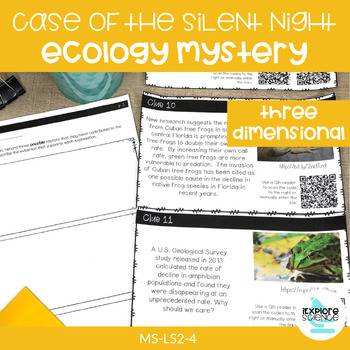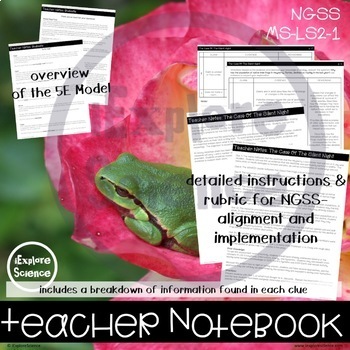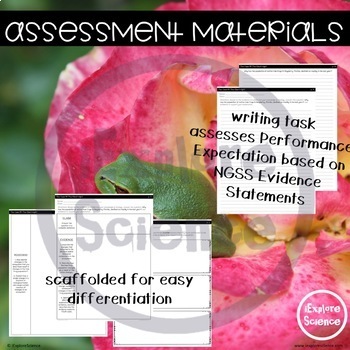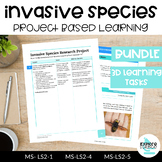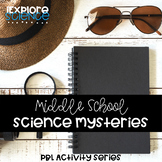Ecology Mystery - C-E-R Changes In Ecosystems, Invasive Species, Habitat Loss
- Zip
What educators are saying
Also included in
- Launch your ecosystems unit through the lens of invasive species - engaging students in real-world phenomena and authentic, project-based learning tasks. This bundle is ideal for teachers who want to add relevancy and excitement to their ecology unit by integrating modern-day environmental issues anPrice $17.00Original Price $25.50Save $8.50
- Engaging students in mysteries and puzzles is a great way to drive learning forward throughout a unit OR assess understanding at the end of a unit. This bundle features activities from the growing Middle School Science Mysteries activity series.Please read the description for each activity to get aPrice $9.00Original Price $11.75Save $2.75
Description
What happens when something disrupts the ability of a system to meet the needs of the organisms within its bounds? In this activity, students will explore what that “something” might be when presented with the problem of a precipitous decline in the native tree frog population of Mayberry, Florida.
In this activity, students will identify possible causes for the “silent nights” Mayberry is now experiencing as the tree frog population has plummeted. While there is no one right answer, students can and should find evidence to support their theories from the clues provided.
MS-LS2-4 Construct an argument supported by empirical evidence that changes to physical or biological components of an ecosystem affect populations.
Other Relevant Content: LS2.A Interdependent Relationships in Ecosystems; LS2.B Cycle of Matter and Energy Transfer in Ecosystems; LS2.C Ecosystem Dynamics, Functioning, and Resilience; LS4.D Biodiversity and Humans
5E Model Phase: Evaluate
Learning Target: Students will analyze qualitative and quantitative evidence to determine possible causes of an amphibian population decline in the fictional town of Mayberry, located in central Florida.
Success Criteria: I can analyze evidence to determine possible causes of a decline in the native frog population of Mayberry.
Success Criteria: I can construct an argument based on evidence that changes to the ecosystem affected native populations.
Prior Knowledge:
To use this assessment most effectively, students should have already addressed several of the concepts in LS2 Ecosystems: Interactions, Energy, and Dynamics. Students may also benefit from having some background knowledge of ESS2 Earth’s Systems and ESS3 Earth and Human Activity.
Because this project has no right or wrong answer, students can take several approaches, and the approach they use will likely be determined by the content they are exposed to during prior instruction.
What’s Included?
✻ Teacher Instructions
⇾ breakdown of the 5E model
⇾ alignment to the standards
⇾ analysis of each clue
⇾ implementation instructions
✻ Student Workbook
⇾ clue analysis graphic organizer
⇾ CER task graphic organizer
⇾ CER prompt
⇾ rubric based on the Performance Expectation and Evidence Statements
✻ Clues
⇾ 15 clues
⇾ links to real news articles and videos
⇾ diary entries
⇾ simple graphs for discussion
⇾ flyers, emails, and memos
Don’t Forget To Check Out These Additional Related Resources…
Changes In Ecosystems -- Data Analysis Lab and CER Writing Task (NGSS MS-LS2-4)
Biotic and Abiotic Factors -- 5E Activity Bundle (NGSS MS-LS2-4)
Changes In Ecosystems Situation Cards: Biotic and Abiotic Factors (NGSS MS-LS2-4)
Invasive Species Project - PBL (NGSS MS-LS2-4 MS-LS2-5)
Activity Pack: Field Notes Food Web
Activity Pack: Where Have All The Tree Frogs Gone? Mystery
Activity Pack: Population Sampling Activity
Terms Of Use:
Copyright © 2018 Nicole VanTassel. All pages of this product are copyrighted, and all rights are reserved by the author. You may not create anything to sell or share based on this packet. The product is created for the use of ONE teacher. Please do not share with colleagues. If they like the product, please send them to my TpT store. I appreciate your support with this request! You are permitted to share ONLY the cover image of this product on your blog or via social media as long as you link back to my product on TpT. Failure to comply is a copyright infringement and a violation of the Digital Millennium Copyright Act (DMCA). Clipart and elements found in this PDF are copyrighted and cannot be extracted and used outside of this file without permission or license. Intended for classroom and personal use ONLY.

